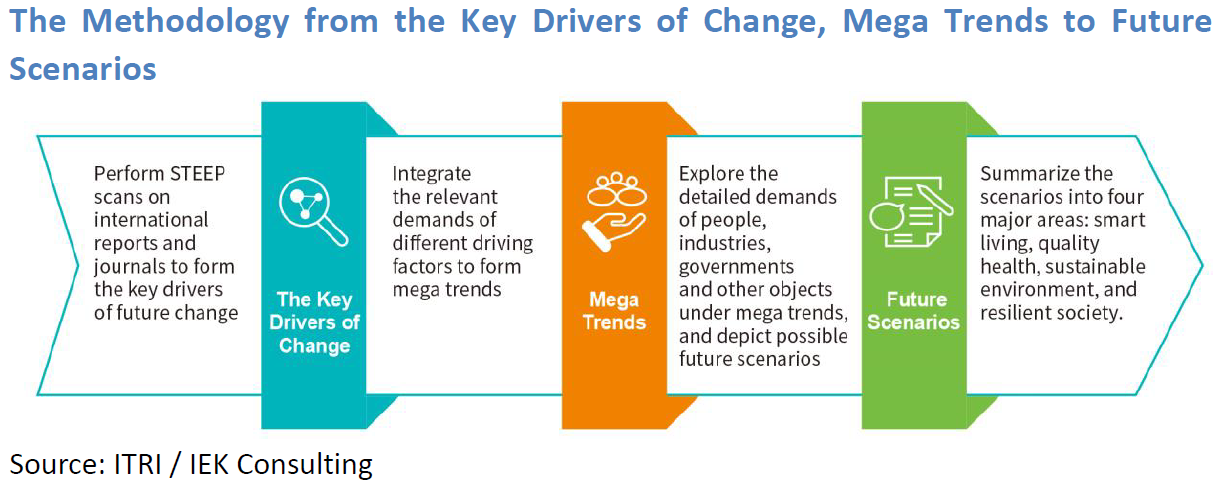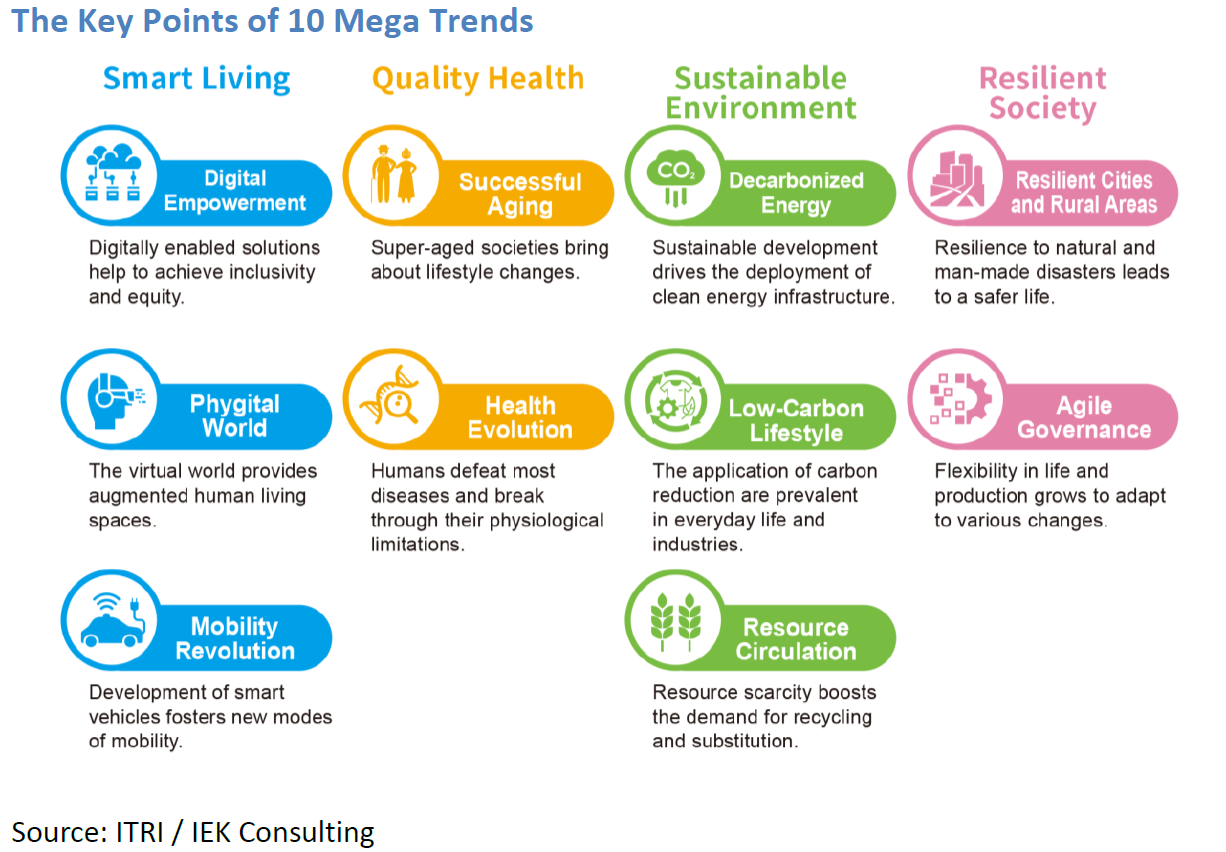Establishing Trends and Scenarios Research Methodology
ISTI has identified the 10 mega trends by investigating the key drivers of change that major economic organizations and think tanks have been monitoring. To build a comprehensive global foresight database, reports and insights were collected from sources such as Economic Co-operation and Development (OECD), the United Nations (UN), World Economic Forum (WEF), International Monetary Fund (IMF), International Energy Agency (IEA), International Institute for Management Development (IMD), World Bank, RAND, McKinsey Global Institute, and The Economists. Through text mining, keywords were generated to discern the directions for universal development and the drivers behind them. Similar demands across sectors were integrated into each mega trend, with future scenarios for 2035 being depicted. Furthermore, expert meetings were held to optimize the implications of these trends and to refine scenario statements within the context of Taiwan. The importance and feasibility of these statements were confirmed to finalize the 10 mega trends for 2035.
Shaping the Mega Trends for 2035
Digital Empowerment
- Platform work popularization and human-AI collaboration: With the rapid development of digital technology, we will see the expansion of AI and automation technology applications, changes in the labor market and working models, and the growth of human-machine collaboration. In the rise of the platform economy, platformwork will be the mainstream, and workers will have to learn to adapt to the digitally enhanced workplace.
- Data analytics for optimizing decision making: As sensing, AI, and big data analysis technologies mature, governments, businesses, groups, and individuals can all use data to enhance their decision making capabilities. For governments, they need to evaluate policy effectiveness in advance. For businesses, they need to design appropriate data management and algorithms to optimize overall supply chain decision making.
Phygital World
- Robots and virtual environments to shape new working models: The widespread application of digital technology solutions and the expansion of virtual workplaces are expected to change the industrial landscape and labor demand. While pursuing a high degree of humanmachine collaboration, we should consider user-friendly interactions a key factor in such digital transformation.
- Seamless integration of real and virtual worlds: Online business activities will gradually be able to provide precise experiences and services to cater to diverse preferences. Immersive technology, an integration of virtuality and reality, will have many applications across industries to meet personalized and adaptative needs. The tasks completed or the results generated in the virtual world will affect the real one. This makes an urgent call to establish a governance and supervision mechanism to ensure information security.
Mobility Revolution
- Self-driving and human-vehicle-road network to improve traffic quality: The Internet of Vehicles is developed to improve traffic and provide safer mobility services. Autonomous driving technology should first be used in mass transportation and commercial fleets to fill the workforce shortage. The development of diverse vehicles and the ways they are used will foster a new generation transportation system.
- Unmanned vehicles used for highrisk, labor-shortage transportation: Unmanned vehicles used for transportation services in remote or dangerous areas, especially in fields such as logistics, disaster relief or accident rescue, can reduce costs and risks.
Successful Aging
- Delayed aging, innovative care and smarter living spaces: Aging-related diseases make the elderly suffer physically and economically, so the future needs new solutions to prevent, delay and treat these diseases. Innovative models should be adopted to alleviate the burden on unpaid caregivers because factors such as declining birthrate, changes in family structure, and reduction in foreign workers for social welfare have widened the demand-supply gap for traditional care services. It is also essential to provide smarter living spaces that are adapted to the elderly lively independently, meeting the need for different family compositions.
Health Evolution
- Break through physiological limitations of human: With technology, people with disabilities can restore their limited senses. The development of wearable devices, for example, expands the range and sensitivity of human senses. Also, artificial intelligence can assist in environment recognition and control the device to improve the quality of life. Meanwhile, people can break through the limitations of physical abilities and satisfy the desire to test their own limits.
- Prevent, control, and overcome diseases and epidemic in daily life: In order to combat aging and illness, technology innovations in the medical sector such as biomedical and AI technologies can help prevent and control diseases, achieving the goals of human health and longevity.
Decarbonized Energy
- Replace fossil fuels with decarbonized/low-carbon energy: Fossil fuels will be phased out with the expansion of clean energy development. The number of electric vehicles will be on the rise. Innovative carbon negative technologies are needed to build a complete hydrogen energy ecosystem for clean transportation.
- Construct highly reliable and resilient power grid systems: The capacity of renewable energy will increase in power girds, and can continue to grow through the flexible use of microgrids, to ensure a fully decarbonized but stable power supply.
Low-Carbon Lifestyle
- Widely use carbon reduction applications in daily life: A guide to a low-carbon lifestyle and innovation in carbon reduction technology will create the opportunity for everyone to play their part in decarbonization. This is the key to achieving net-zero emissions. In response to the impact of climate change, countries are committed to planning pathways towards net-zero emissions. Carbon sink offset projects, including the development of natural carbon sinks, will play crucial roles.
- Green manufacturing processes by industry to meet net-zero emission: Industries are under mounting pressure from international net-zero carbon emission requirements such as the carbon reduction goals and the increasing trade barriers. They need technological innovation and investment to improve process efficiency and reach net-zero by 2050. Heavy industry’s efforts in carbon reduction will be aided by pre-commercial technologies such as hydrogen or carbon capture, utilization and storage (CCUS) technology to move towards net-zero targets.
Resource Circulation
- Innovation in recycling-oriented material: Material innovation for recycling and reuse offers an effective path to reduce industrial carbon emissions. The large-scale development of clean energy technologies will trigger the growth of key metal and rare earth mineral recovery technologies (involving processes such as using waste resources as raw materials, integrating, dismantling and crushing; separation and sorting; extraction and purification; developing formula for the regeneration of high-quality rare earth powders).
- Establish water resource reuse and land redevelopment systems: In addressing the escalating global water shortage, we need to improve technologies for water collection, desalination, water use efficiency, wastewater treatment, and water recycling. Businesses need to take actions to become net water positive, or replenish more water than they use. It is also necessary to mitigate land degradation to ensure a stable food supply chain.
Agile Governance
- Enhance intelligent management of industries for human-centric work models: To meet food demand, biological and digital technologies must be integrated to develop precision agriculture. In the context of restructuring supply chains, smart manufacturing will improve the efficiency and accuracy of decentralized production. As production activities evolve, human workers remain essential in the manufacturing process but will embrace more flexibility in human-machine collaboration.
Resilient Cities and Rural Areas
- Develop environmental changes adapting system and disaster alert mechanisms: Due to the severe impact of climate change on our living environment, countries will strengthen infrastructure that can coexist with extreme weather and develop early warning and response capabilities for disasters.
- Establish cross-border cybersecurity mechanism and certification standards: In the face of rising cyber threats, there is a need to establish a more complete cyber security mechanism. Information security will become a major topic of international multilateral cooperation, and various digital innovations will be promoted through democratic participation.
- Enhance autonomy in critical digital infrastructure: Countries will accelerate the research and development of new generation communications and critical digital applications. However, due to digital sovereignty, there will be different cooperation alliances around the world. Ensuring the autonomy of independent digital infrastructure will be a vital issue.
Developing Technology Strategy Based on the Mega Trends
Incorporating the 10 mega trends, we have examined the relationships between technologies across domains and identified a wide range of issues that cannot be solved without cross-domain technological collaboration. We have thereby adjusted ITRI’s 2035 Technology Strategy & Roadmap based on these trends. Such efforts have aligned our R&D layout more accurately with the future needs of the government, industry and individuals.



